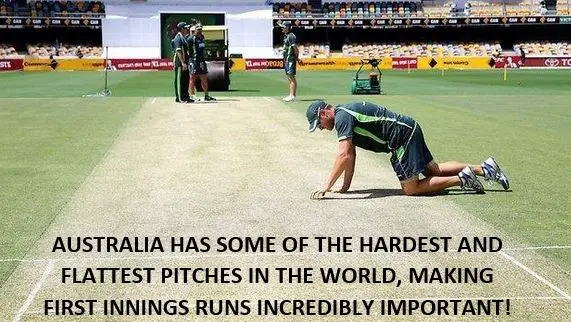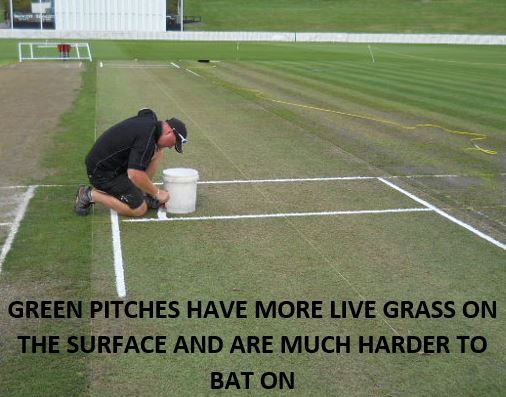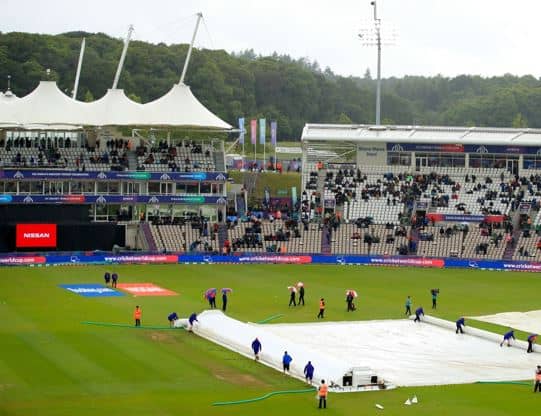The decision whether to bat or bowl first at the start of a cricket match is arguably the most important decision a captain has to make. Making the correct choice can send your team on their way to winning the game, while making a poor choice can put your team on the back foot from ball number one.
There are bad decisions at the toss which have gone down in cricketing history. The main one which immediately springs to mind is Ricky Ponting’s decision to bowl first at Edgbaston in the 2005 Ashes on a flat pitch just after Glenn McGrath had gone down injured. England ended up scoring a mammoth 407 on the first day of the test match and went on to win by 2 runs in one of the best test matches of all time!
Given how important it is to make a good decision at the toss, a lot of inexperienced captains end up wondering what factors they should be looking at when choosing whether to bat or bowl. Which types of pitches suit bowling first? Which types of overhead conditions make batting easier? This is what I’m going to take you through today in this post!
So, how do you decide whether to bat or bowl first in cricket?
To decide whether to bat or bowl, a captain should be considering the following things:
- The condition of the cricket pitch
- The overhead weather conditions
- The quality and strengths of their team, as well as the opposition team
- The weather forecast for the rest of the match
- The format of cricket being played
I’ll now take you through each of these factors in more detail so that you know exactly what you need to look for before deciding whether to bat or bowl.
The Condition Of The Cricket Pitch
This is probably the most important factor that will influence your decision at the toss. The type of pitch that you’re playing on has a huge impact on how the ball behaves and how hard it is to bat once you get to the crease. In the next few paragraphs I’ll describe some pitch conditions that captains are likely to encounter, and I’ll describe how these conditions can influence their thinking. Let’s get into it…
Hard & Flat Pitches
When the captains walk out to toss the coin on the day of a match and see a hard, flat pitch with no imperfections or grass on the surface, you can almost guarantee that both of them will be aiming to bat first! This is especially true during a test match or a game that lasts 4/5 days.
Captains decide to bat first on pitches like this because the pitch will probably be at its best during the time they’re batting. The ball is unlikely to seam around too much, and it is also likely to come on to the bat very nicely, making it easier to time each shot.
Captains will be hoping that their team bat well and rack up a big score so that they can put pressure on the other team in the second innings. Hopefully by the time the second innings arrives the pitch will have begun to deteriorate, leading to inconsistent bounce and extra turn for the spin bowlers.

Grass On The Pitch
When the captains see plenty of grass on the surface of the cricket pitch this will tell them that it may be a very good surface for their fast bowlers to bowl first on. However, this can often depend on the type of grass that is on the pitch.
For example, if the grass on the pitch is very green this means that there is probably a lot more moisture in the surface. This is great for fast bowlers who like to try to nip the ball off the seam because the moisture in the pitch makes that more likely to happen. Therefore, it may be very difficult to bat first on a pitch like this. You’re more likely to see green pitches in countries like England which have wetter climates, especially early on in the cricket season!
If the grass on the pitch is quite dry and looks yellow-ish in colour, this means that there isn’t a lot of moisture in the surface and that the pitch will probably be pretty decent for batting. There may be a bit of movement for the bowling side to make use of over the first day, but beyond that usually flatten out before starting to spin later in the match.
In conclusion, if a captain sees a very green, grassy pitch then they may be more likely to bowl first rather than bat first. If the grass is drier and yellow in colour, this suggests that the pitch may be slightly more favourable for batting first, but there may still be opportunities for the bowlers to get the ball to seam and move around early in the innings.

Previously Used Pitches
A lot of limited overs matches take place on ‘used pitches’. These are pitches that have been used in one or a few previous matches. For example, if there were three T20 matches taking place at The Oval over the course of a week, two of these games (or maybe even all three) could potentially be played on the same pitch.
If a captain wins the toss in a game that is being played on a used pitch, they will often look to bat first. This is because the pitch will usually have deteriorated in condition quite a bit during the previous games that were played on it. Therefore, the team batting first will usually get the best batting conditions. By the time their innings has finished and it’s their turn to bowl, the pitch will have deteriorated even further and will probably spin more. It may also lead to more uneven bounce, which is very difficult for the team batting last to deal with.
This is unlikely to be a factor when it comes to 4 day and 5 day cricket matches, because they are almost never played on used pitches. But in short form cricket tournaments like the IPL, the T20 Blast or The Hundred they are often a feature!
Dry Pitches
If a captain wins the toss on a very dry, dusty pitch then they will most likely decide to bat first. This is why teams usually look to bat first when they win the toss in sub-continent countries like India or Pakistan where dry pitches are more common.
On dry and dusty surfaces, the ball spins more unpredictably as the game goes on. It can also bounce a lot more unpredictably. This means that the team who bats first will be batting when the pitch is at its truest – which is a great advantage!
If a test match is being played on a dry and dusty surface, the team who bats first will probably end up getting the best of the batting conditions in the first innings, and the best of the bowling conditions in the fourth innings. By the time the fourth innings arrives the pitch will probably have begun to spin a lot more violently, so any team that has competent spin bowlers should relish bowling last on these types of surfaces.
To summarise, if a pitch looks dry on the first day, it’s likely that it’s going to spin a lot and crack up as the game progresses, and in this situation you should almost always be aiming to bat first.
The Overhead Weather Conditions
The weather at the time of the toss also plays a big role in deciding whether to bat or bowl first. Certain weather conditions are regarded as more favourable for batting, and others help the bowlers out significantly.
If it’s a very hot day and the sun is baking the pitch, then captains will usually decide to bat first. If there is rain in the air or if the weather is very overcast with plenty of clouds, then a captain may decide to bowl first instead. That’s because overcast and cloudy weather conditions generally help fast bowlers to swing the ball, and moisture in the pitch from wet weather usually helps bowlers to get seam movement.
If the weather is overcast but the pitch is hard and flat, then the captains may still choose to bat because of the favourable pitch conditions. In this situation they will be hoping that their opening batsmen can bat through the tough weather conditions and see off the new ball.
To summarise this section, the weather at the time of the toss definitely plays a role in a captain’s thinking for the reasons I’ve laid out above, but it probably isn’t as important as the condition of the pitch.
The Quality & Strengths Of Both Teams
Certain cricket teams will have strengths and qualities that make them more suited to batting first, and others will have different qualities that suit bowling first.
For example, if a captain knows they have a particularly weak batting line up as well as decent set of bowlers, then they may wish to bat second whenever they win the toss. Especially if they’re playing a 20 over or a 50 over match! By doing this, they can try to use their good set of bowlers first to restrict the opposition to a sub-par total. If they achieve this, it will be easier for their batsmen to chase down that smaller target. Teams with weaker batting line ups should always strongly consider batting second in limited overs games because it’s usually a lot easier for them to chase down a total than it is for them to set one!
Similarly, if a captain knows that the opposing team’s top order batsmen are of low quality, or if they’re in a bad run of form, making them bat first in good bowling conditions is always a good tactic.
Additionally, surveying the strengths of the opposition can help you make better decisions at the toss. For example, a captain that wins the toss in a test match may be wise to bat first if the opposition team has a world class spin bowler like Shane Warne or Ravi Ashwin. By batting first, this makes it more likely that they won’t have to face the opposition spin bowler in the last innings of the game, when spin is the hardest to play. Bowlers like Warne, Ashwin and Murali can be unplayable on turning surfaces, and this is one of the reasons why teams that won the toss against the great Australian team featuring Shane Warne rarely chose to bowl first. Nobody wanted to be facing Warne in the fourth innings of a test match if they could avoid it!
The Weather Forecast For The Rest Of The Match
We’ve already discussed how weather conditions at the time of the toss may impact the decision of whether to bat or bowl, but what about the weather forecast for the remainder of the game? This is definitely something that captains should be aware of when making their decision.
To explain how a weather forecast can influence a captain’s decision, let’s look at some examples. Let’s say a T20 match is taking place in the IPL in India and it is a day-night game that will be played under floodlights. In this situation, a captain may want to look at a forecast to see how much dew is likely to be present in the second half of the game. If it looks like there’s going to be a lot of dew as the game progresses, the captain that wins the toss should probably choose to bowl first, because dew can make it much harder for the bowling team in the second half of a limited overs match (click here to read about exactly how dew impacts cricket matches).
As a second example, let’s say that a test match is taking place between India and England at Lords in the UK. As the toss is taking place the weather is very overcast with plenty of clouds around, which suggests that conditions would suit bowling first. However, the forecast shows that this overcast weather will clear pretty quickly and give way to blue skies and bright sunshine for the rest of the match. In this situation, the captain winning the toss may just choose to ignore the favourable bowling conditions and bat first, given that the bowler-friendly skies aren’t likely to last very long!
To summarise this section, the weather forecast is definitely something that should play a part in a captain’s decision at the toss, but it probably isn’t the most important factor! As we all know, weather forecasts can be spectacularly inaccurate, so basing your decision whether to bat or bowl entirely on them probably isn’t the smartest idea! However, combining the weather forecast with the condition of the pitch should give you a good idea of whether you should be batting or bowling first.

The Format Of Cricket Being Played
As most of you will know – there are currently many different types of cricket that are played across the world. The main three types of cricket are 20 over matches, 50 over matches, and 4/5 day matches. Often, the type of cricket being played will help a captain determine what they would like to do if they win the toss.
For example, the England ODI/T20 team that has been led incredibly successfully by Eoin Morgan over the last few years love to chase runs in the second innings – that is their preferred method of winning a match. They have done this incredibly successfully for years now! So, more often than not, when England win the toss in the short format of the game Eoin Morgan will choose to bowl first and ask the opposing team to set a target. Obviously, the England team do also take conditions and the opposition into account. So, when playing certain other teams, and when playing on hard and flat pitches, Eoin Morgan may choose to bat first – but I’d guess that his first thought is often to bowl!
This type of thinking rarely occurs in test and 4 day cricket because those formats of the game are much longer and teams usually have to bat twice.
Conclusion
I hope that in this post I’ve managed to give you a bit of a framework which you can base your decision to bat or bowl on. In summary, remember the following things:
- In test matches/4 day matches most captains will generally look to bat first, unless the match is being played on a very green, grassy pitch or in very favourable weather conditions for bowling.
- Batting first usually gives you an advantage in test matches and four day games, because you’ll often be batting when the pitch is at its best. You’ll also probably end up bowling last – when the pitch has deteriorated significantly and will be at its hardest to bat on.
- In short formats of the game like ODI’s and T20’s, captains may choose to bowl first simply because they prefer chasing a target in the second innings rather than setting one in the first innings.
- In the shorter formats, the pitch is unlikely to deteriorate too much between the first and second innings so bowling first and batting at the end of the match is a lot more viable than it is in a test match!
- Previously used pitches and dry pitches often favour batting first, because they are likely to spin a lot more as the game progresses. Ideally, the captain that wins the toss will want to be bowling last when the ball is spinning the most – especially if they have a top spin bowler in their ranks!
